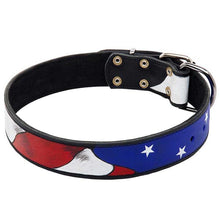What Is An E-Collar And Why Is It Used?

There are several different types of "e-collars." No Bark collars, underground fence collars, GPS collars, remote training collars etc. All are collars, all use electricity. But when people say "e-collar," they are usually referencing remote training collars.
● What are remote training collars?
Remote training collars consist of a battery operated collar fitted with electrodes and a receiver, and a remote control unit. It uses radio waves to control the stimulation to the vibrate function and electrodes.

● How do remote training collars work?
On the remote, there are settings to control the level of stimulation, usually a vibrate function, and at least 3 buttons to control whether you're using vibrate, a single, split second of stim, or a continuous stim button.
● How are remote trainers used?
Remote trainers are most commonly used in 3 ways.
1: To get a dog's attention by using an extremely low level that can barely be felt. The purpose of using it this way is to regain engagement with your dog when they lose focus. The dog will feel something akin to a fly buzzing on them and remember that they're supposed to be doing something ... which is to be engaged with you during training.

2: As a means of negative reinforcement. Have you ever sat in your car without your seat belt on, but that annoying "ding ... ding ... ding" eventually convinced you to put on your seat belt to get it to stop annoying you? Well, the collar can be used this way as well. For instance, you tell a dog to come to you, then apply the stim at a low level, as before, until they get annoyed with the buzzing and return to you as asked. This method is used less these days, but is still very prominent in upland game hunting and waterfowl hunting.
3: To teach a dog that what it's doing is wrong or dangerous and not to do it again. This is a correction. Using this method, the level of stim is usually higher. This is to let a dog know that it's doing something that it cannot do. Whether that be digging holes in the yard, tipping over the trash, completely ignoring commands that the dog understands and knows well etc.
● Are remote trainers necessary to train a dog?
No, they're not. People have been training dogs to high levels long before remote trainers were a thing. A long line and a lot of training can have a dog trained off leash just as good as a remote trainer.

● If remote trainers aren't necessary to train a dog, why do people use them?
Many people see remote trainers as horrible devices. Many people see them as an efficient way to train dogs. The reality is that both groups are right ... and both are wrong. A remote trainer is just a tool. It's just another way to communicate with your dog. You can make a dog excited with a remote trainer, you can calm a dog down with a remote trainer. You can teach a dog to never do something again with a remote trainer. You can even help a dog navigate by using one. For example, two vibrates back to back could be "go to your right." While one vibrate feature can mean to "go to your left." There are so many ways you can use a remote trainer to do amazing things with your dog. And there are just as many things you can do using a remote trainer that are counterproductive and can set you and your dog back.
● Should I use a remote trainer?
It depends. What are you trying to train? What are you trying to communicate to your dog? Do you understand basic dog training? Where will you be using it and why? If you can't answer all of those questions, do you have a qualified dog trainer locally who has the experience to help you and teach you how to use the remote trainer?

● Are remote trainers a shortcut in dog training?
It depends how it's used. Using one can take longer than using other tools and be milder. Or it can be used to expedite training a dog to be fully trained. Fully trained as in no leash, nor remote trainer are necessary. If your dog will not follow commands with no safety net of a leash or remote trainer, the dog isn't fully trained.
● Who uses remote trainers?
Some of the best trainers on the planet use them. A lot of bird hunting guys use them to help communicate with their dog at long distances. A lot of dog sport champions have used them. A lot of military trainers have used them. A lot of police spanners use them. Many of these people have written books on using them.
● Advantages.
It can be used just like a leash and collar. No getting tangled and hurting yourself or your dog while accidentally hog tying yourself with a 33ft long tracking leash. Another advantage of using a remote trainer is timing when you’re correcting a behavior. Many times it’s difficult to correct your dog the moment they’re doing something they shouldn't. Correcting your dog as soon as they do something is important for them to understand their behavior is wrong. It’s especially effective if you’re working on off leash training. And in those training instances without a leash, if your dog decided to bolt towards trafficking, you can still correct them at distance. It could be the difference between a training error that ended well vs a dog who gets hit by a car.

● Negatives.
People who have no familiarity with remote trainers will tell you their opinions on something they don't understand. You will be annoyed.
Good remote trainers are typically $150-over $300. They're a tad pricey, but one in that price range will be waterproof, rechargeable, and last forever if you take care of them.
You have to be a competent dog trainer to use one. And then you'll have to train with someone who is not just a good trainer, but someone who is versed in using the remote trainer.
● Conclusion.
E-collars aka remote trainers are just like any other training tool. They can be used to communicate effectively thanks to competence, or misused do to malice or incompetence. The choice to use one or not is up to you. And whether or not you're for them, against them, or somewhere in between ... take this dog training advice that I received once, many years ago:

Don't take dog training advice from someone who isn't comfortable walking their dog off leash in the middle of a petting zoo or the side of a very busy freeway. If they have to worry that their dog may do something bad or dangerous, they don't trust their own training. And if they can do those things and are fully confident? It's worth having a conversation with them. You might not see eye to eye on the subject at hand, but one of you is probably better at communicating certain things to certain types of dogs better than the other. Never stop learning.
Thank you for your support of this page. Please leave a like and share, and never stop learning!
You may also like: Should You Ever Use A Prong Collar On Your Dog?
























